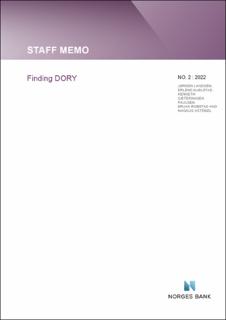| dc.contributor.author | Landsem, Jørgen | |
| dc.contributor.author | Njølstad, Erlend | |
| dc.contributor.author | Paulsen, Kenneth Sæterhagen | |
| dc.contributor.author | Robstad, Ørjan | |
| dc.contributor.author | Åstebøl, Magnus | |
| dc.date.accessioned | 2022-02-14T10:45:14Z | |
| dc.date.available | 2022-02-14T10:45:14Z | |
| dc.date.issued | 2022 | |
| dc.identifier.isbn | 978-82-8379-223-2 | |
| dc.identifier.issn | 1504-2596 | |
| dc.identifier.uri | https://hdl.handle.net/11250/2978716 | |
| dc.description.abstract | This paper describes the semi-structural model DORY used by Norges Bank as a link between raw data, sector experts and the core policy model NEMO. While the primary objective in NEMO is to analyse business cycle fluctuations and monetary policy, DORY is used to identify the underlying trends in the main macro variables in Norway. DORY has been gradually developed over the last couple of years and has now been estimated using state of the art Bayesian estimation techniques. | en_US |
| dc.language.iso | eng | en_US |
| dc.publisher | Norges Bank | en_US |
| dc.relation.ispartofseries | Staff Memo;2/2022 | |
| dc.rights | Attribution-NonCommercial-NoDerivatives 4.0 Internasjonal | * |
| dc.rights.uri | http://creativecommons.org/licenses/by-nc-nd/4.0/deed.no | * |
| dc.title | Finding DORY | en_US |
| dc.type | Working paper | en_US |
| dc.description.version | publishedVersion | en_US |
| dc.subject.nsi | VDP::Samfunnsvitenskap: 200::Økonomi: 210::Samfunnsøkonomi: 212 | en_US |
| dc.source.pagenumber | 36 | en_US |

